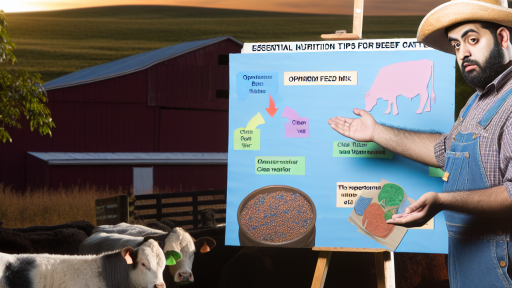Understanding Seasonal Changes and Their Impact on Livestock
Effects of Temperature Variations
Temperature fluctuations directly influence livestock health.
Animals can experience stress during extreme heat or cold.
Proper transportation planning minimizes these risks.
Humidity and Its Role
High humidity levels can lead to respiratory issues in livestock.
Therefore, monitor humidity closely during transport.
Providing adequate ventilation helps maintain comfort.
Seasonal Nutrition Needs
Livestock nutrition changes with the seasons.
Winter often requires higher energy feeds to maintain body heat.
In contrast, summer diets may need more water and minerals.
Planning for Weather Conditions
Adverse weather can disrupt transportation schedules.
Always check forecasts before planning transport.
Prepare for potential delays due to snow or rain.
Health Monitoring Practices
A seasonal change can trigger health issues in livestock.
Regular health assessments are essential during transport.
Vaccinations can prevent seasonal diseases effectively.
Transform Your Agribusiness
Unlock your farm's potential with expert advice tailored to your needs. Get actionable steps that drive real results.
Get StartedEmergency Preparedness
Always have a contingency plan for unexpected events.
Ensure that first aid kits are accessible during transport.
Properly train staff to handle emergencies with livestock.
Preparing Transportation Vehicles for Seasonal Conditions
Vehicle Inspection and Maintenance
Regularly inspect your vehicles before each season starts.
Check all fluid levels, including oil, coolant, and brake fluid.
Examine the tires for wear and proper inflation.
Ensure that brakes function effectively under varying conditions.
Additionally, inspect lights and signals to ensure visibility.
Adaptations for Weather Conditions
Different seasons require specific adaptations for your transport vehicles.
In winter, ensure your vehicles are equipped with anti-freeze and snow chains.
During summer, consider additional ventilation options for animals.
Use tarps or covers to protect livestock from rain and sun exposure.
Adjust your vehicle’s weight distribution during different seasons.
Temperature Control Measures
Monitoring internal temperatures is crucial during transportation.
Install temperature tracking devices in your vehicles.
Use fans or air conditioning during hotter months for livestock comfort.
In colder months, provide insulated bedding to keep animals warm.
Always aim to maintain a stable environment for the animals.
Emergency Preparedness
Being prepared for emergencies is essential year-round.
Keep basic first-aid supplies for both livestock and drivers in your vehicle.
Familiarize yourself with local emergency contact numbers.
Develop an emergency plan for each season, addressing unique risks.
Lastly, conduct regular training on emergency procedures with your team.
Managing Stress Levels in Livestock During Transportation
Understanding Livestock Stress
Transportation can induce stress in livestock.
Showcase Your Farming Business
Publish your professional farming services profile on our blog for a one-time fee of $200 and reach a dedicated audience of farmers and agribusiness owners.
Publish Your ProfileThis stress affects their health and well-being.
Additionally, it can influence their performance post-transport.
Therefore, understanding the causes of stress is paramount.
Identifying Stressors
Several factors contribute to stress in livestock during transport.
- Temperature fluctuations can increase stress levels.
- Noise from vehicles and loading areas can be overwhelming.
- Crowding within trailers can lead to anxiety.
- Inadequate ventilation can compromise their comfort.
Pre-Transportation Preparations
Proper planning is crucial for reducing stress.
Start by assessing the weather conditions before transport.
It’s essential to avoid transporting during extreme heat or cold.
Furthermore, acclimatizing animals to handling reduces anxiety.
During Transportation
Maintaining a calm environment helps keep livestock stress-free.
Limit loud noises by using quiet-loading techniques.
Ensure adequate space within the transport vehicle.
Moreover, provide proper ventilation to regulate temperature.
Post-Transport Care
Recovery begins immediately after unloading.
Provide livestock with fresh water and food promptly.
Check for any signs of distress or injury after transport.
Allow animals time to acclimate to their new environment.
Consulting Professionals
Consider seeking advice from experienced veterinarians.
Experts can offer guidance on best practices for transport.
Training staff on handling techniques also proves beneficial.
Continuous education ensures optimal care for livestock.
Delve into the Subject: Enhancing Herd Quality with Genetic Tools
Adapting Feeding and Hydration Strategies for Different Seasons
Spring Considerations
In spring, livestock require a nutrient-rich diet to support growth.
Provide ample access to fresh grass, as it becomes more abundant.
Ensure livestock stay hydrated, as warm weather can increase their water needs.
Monitor pasture conditions to prevent overgrazing.
Summer Strategies
In summer, heat stress can impact livestock health.
Adjust feeding schedules to avoid peak heat times.
Consider providing electrolytes in water to help combat dehydration.
Increase the frequency of water checks to ensure all animals have access.
Autumn Adjustments
During autumn, livestock begin to prepare for colder months.
Ensure they receive adequate energy through high-quality forage.
Supplement with grain if necessary to support their increasing caloric needs.
Continue to monitor hydration levels as temperatures fluctuate.
Winter Preparations
In winter, livestock face the cold, requiring additional feed adjustments.
Prioritize energy-dense foods to sustain body heat.
Provide clean, unfrozen water at all times; consider heated troughs.
Evaluate shelter conditions and provide bedding to protect against the cold.
Year-Round Practices
Regardless of the season, maintain consistent feeding routines.
Regularly assess the nutritional content of feed to meet changing needs.
Incorporate dietary supplements as necessary based on seasonal demands.
Showcase Your Farming Business
Publish your professional farming services profile on our blog for a one-time fee of $200 and reach a dedicated audience of farmers and agribusiness owners.
Publish Your ProfileAlways consult with a veterinarian or nutritionist for tailored advice.
Discover More: Health and Safety Guidelines for Livestock Handling
Ensuring Animal Welfare: Legal Requirements and Best Practices
Understanding Legal Requirements
Each country has specific legal frameworks for animal transportation.
Regulatory bodies oversee these laws to ensure compliance.
For example, the Animal Welfare Act in the United States sets clear guidelines.
This act mandates proper treatment and care during transportation.
Familiarize yourself with local regulations to avoid legal issues.
Violating these laws can result in penalties or revocation of licenses.
Implementing Best Practices
Begin with proper training for all personnel involved.
Ensure they understand animal handling and welfare principles.
Develop a comprehensive transportation plan tailored to your livestock’s needs.
Regularly inspect vehicles for safety and comfort.
Ventilation and temperature control are crucial during transport.
Monitor animals closely throughout the journey.
Providing Adequate Nutrition and Hydration
Fresh water should be available at all times during transport.
Plan feeding schedules according to the livestock’s species and age.
Ensure that nutritional needs are met to maintain health.
Consider the duration of travel when planning feed and water breaks.
Handling Emergencies Effectively
Prepare for potential emergencies during transportation.
Have a first-aid kit readily available in your transport vehicle.
Train staff on how to handle emergency situations quickly.
Develop protocols for common health issues that may arise.
Document any incidents to improve future transport safety.
Monitoring Stress Levels
Stress can significantly impact animal welfare during transport.
Recognize signs of distress, such as excessive vocalization and agitation.
Use soothing techniques to help calm nervous animals.
Limit transport duration whenever possible to reduce stress.
Understand the behavioral traits of different species to respond effectively.
Encouraging Positive Outcomes through Communication
Maintain open lines of communication with all stakeholders involved.
Share your transportation plan with suppliers and veterinary staff.
Solicit feedback regularly to improve processes.
Encouraging transparency will build trust and promote better welfare outcomes.
See Related Content: Genetic Factors Influencing Livestock Fertility

Monitoring Weather Conditions and Adjusting Transport Plans
The Importance of Weather Monitoring
Weather directly impacts livestock transportation.
Extreme temperatures can stress animals during transport.
Consistent monitoring helps ensure animal welfare.
Adaptation to weather changes safeguards livestock health.
Tools for Weather Monitoring
Various technologies assist in effective weather monitoring.
Mobile apps provide real-time weather updates.
Weather websites offer detailed forecasts for specific regions.
Showcase Your Farming Business
Publish your professional farming services profile on our blog for a one-time fee of $200 and reach a dedicated audience of farmers and agribusiness owners.
Publish Your ProfileFarmers can use radar systems for immediate changes.
Anemometers measure wind speeds crucial for transport safety.
Adjusting Transport Plans
Flexibility in transport plans is essential.
Altering routes may avoid adverse weather conditions.
Postponing transport during extreme weather is often necessary.
Consider scheduling movements during cooler times of day.
Plan additional stops for hydration and rest as needed.
Communicating Changes
Communication with all parties involved is vital.
Notify drivers about adjustments in real time.
Update stakeholders on potential delays or changes.
Clear communication reduces confusion and stress.
Evaluating Transport Conditions
Regular assessments improve the quality of transport operations.
Document weather conditions during previous transports.
Analyze the impact of weather on livestock well-being.
This information helps refine future operational strategies.
Delve into the Subject: Crossbreeding vs. Purebreeding: Pros and Cons
Strategies for Loading and Unloading Livestock Safely in Various Seasons
Spring Considerations
Spring weather can vary significantly.
Ensure livestock are acclimated to the temperatures.
Use non-slip surfaces while loading and unloading.
Consider the potential for mud or wet conditions.
Keep a close watch on the animals’ stress levels.
Summer Strategies
Heat stress is a major concern in summer.
Load animals during cooler parts of the day.
Provide plenty of water before loading.
Maintain ventilation in transport vehicles.
Regularly check on the animals during transport.
Autumn Practices
With falling temperatures, prepare for colder conditions.
Monitor for signs of hypothermia in transported livestock.
Use appropriate bedding to keep animals warm and dry.
Ensure loading areas are free from ice and snow.
Adjust loading times based on weather predictions.
Winter Techniques
Winter presents unique challenges for livestock transport.
Bundle animals closely to retain body heat.
Check road and loading conditions regularly for safety.
Use additional bedding to avoid cold from the floor.
Provide breaks during long journeys to assess livestock welfare.
Post-Transportation Care: Health Checks and Recovery Guidelines
Initial Health Assessment
Conduct a health check immediately after arrival.
Examine each livestock animal for signs of stress or injury.
Look for unusual behaviors that indicate discomfort.
Prioritize the evaluation of vital signs such as temperature and respiration.
Showcase Your Farming Business
Publish your professional farming services profile on our blog for a one-time fee of $200 and reach a dedicated audience of farmers and agribusiness owners.
Publish Your ProfileProviding Adequate Hydration
Ensure all animals have access to fresh water right after unloading.
Monitor water intake to confirm animals are rehydrating properly.
Use bucket systems if animals are hesitant to drink from troughs.
Consider electrolyte solutions for stressed or dehydrated animals.
Nutritional Support for Recovery
Introduce high-quality feed gradually to avoid digestive issues.
Provide energy-rich supplements to help restore strength.
Observe eating habits to assess recovery and adjust feed accordingly.
Rest and Comfort
Allow animals to rest in a safe and quiet environment.
Minimize noise and disturbances during the recovery period.
Ensure proper bedding is provided to maintain comfort levels.
Monitoring for Complications
Continue to monitor all animals for any symptoms of illness.
Be alert for signs of respiratory issues or unusual swelling.
Document any health concerns for further veterinary consultation.
Follow-Up Care
Schedule follow-up health assessments within the next week.
Keep communication open with your veterinarian for further advice.
Review feeding and management practices based on animal responses.
Additional Resources
Targeted Grazing for Wildfire Fuel Breaks | USDA Climate Hubs




